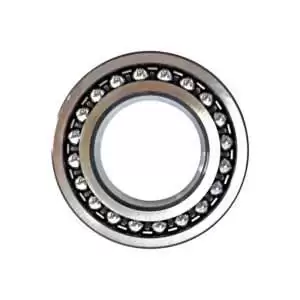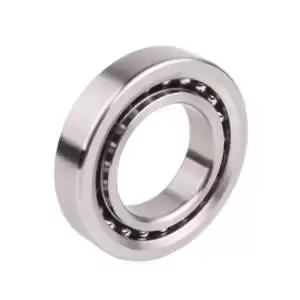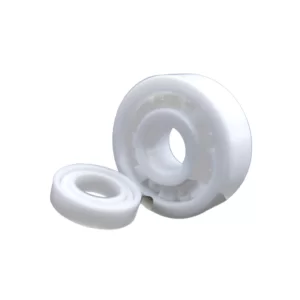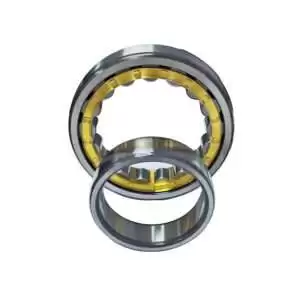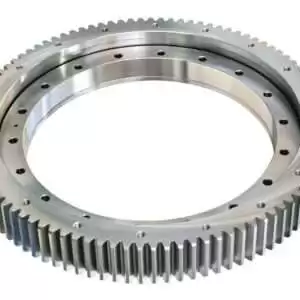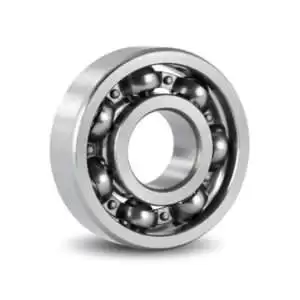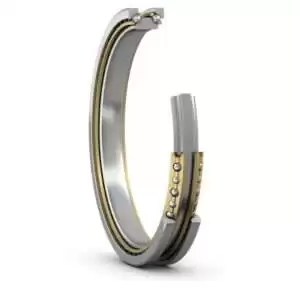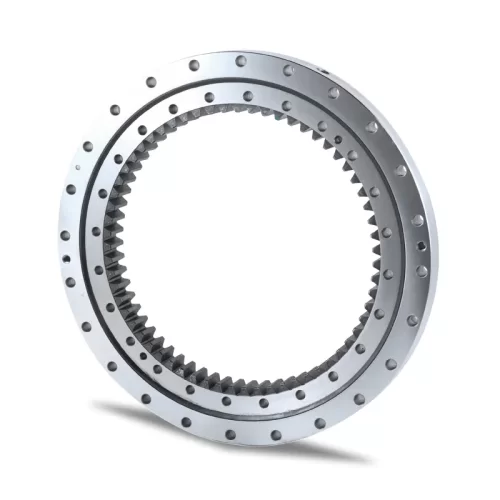Categories Turntable bearings, also known as slewing rings or rotary bearings, are specialized components designed to facilitate smooth rotational motion in applications requiring axial, radial, and moment load support. These bearings provide a critical interface between stationary and moving parts, allowing for seamless movement while supporting heavy loads. Unlike traditional bearings, turntable bearings feature a wide raceway and often integrate multiple rolling elements—such as balls or rollers—enabling them to handle significant weight while rotating smoothly in a full 360 degrees. The significance of turntable bearings becomes particularly evident in heavy-load scenarios where precise, continuous rotation is essential. In industries such as construction and heavy machinery, these bearings are engineered to withstand immense forces while maintaining optimal rotational performance. This capability is crucial for applications ranging from cranes and excavators to wind turbines, where the ability to rotate freely without compromising stability can mean the difference between efficiency and costly downtime. Turntable bearings ensure that heavy equipment can operate reliably, enhancing both productivity and safety in demanding environments. Turntable bearings play an indispensable role across various industries, contributing to innovations in machinery and equipment. In construction, they support heavy machinery that requires precise rotation, enabling efficient material handling and site operations. The robotics industry leverages these bearings to achieve high precision and reliability in automated systems, where even the slightest misalignment can lead to significant operational failures. Furthermore, in manufacturing, turntable bearings are integral to conveyor systems and assembly lines, facilitating smooth movement of products and components. Their versatility and adaptability make them essential in any application requiring reliable rotary motion, cementing their status as a foundational technology in modern engineering. High-load environments are characterized by significant weight and stress on machinery, where equipment is subjected to substantial forces during operation. In these scenarios, the role of turntable bearings is paramount; they must withstand the rigors of continuous use while maintaining operational integrity. Understanding the nuances of these environments is crucial for selecting the appropriate bearing type and ensuring long-term performance. Various industrial sectors rely heavily on turntable bearings to facilitate their operations. Industries such as construction, mining, manufacturing, and robotics utilize these bearings for their ability to handle heavy loads and provide smooth motion. For instance, cranes depend on turntable bearings to rotate heavy loads with precision, while automated manufacturing lines require these bearings to move components accurately and reliably. Working in high-torque conditions presents unique challenges, including wear and tear, thermal expansion, and the need for regular maintenance. The high forces involved can lead to increased friction and heat generation, necessitating the use of high-quality lubricants and regular inspections. Additionally, the complexity of these applications often requires custom solutions, highlighting the importance of understanding the specific demands of each environment to prevent premature failure. Turntable bearings are engineered to handle substantial axial, radial, and moment loads simultaneously. This makes them ideal for applications like cranes, wind turbines, and industrial robots, where they can support both heavy and light loads without compromising on performance. Their ability to distribute forces evenly across the bearing surface allows for smooth rotation even under significant pressure. These bearings ensure seamless 360-degree movement, which is critical in applications requiring continuous or repetitive rotation. The precise design of turntable bearings reduces friction and wear, allowing for smooth operation over long periods. Whether in a high-speed manufacturing process or a precision medical device, this smooth rotation is vital for maintaining efficiency and accuracy. Constructed from robust materials like hardened steel, stainless steel, or aluminum, turntable bearings are built to withstand the harshest conditions. Their durability ensures that they can endure constant use in demanding environments, from outdoor construction equipment to corrosive environments like marine applications. The high-quality materials and design also contribute to a longer operational life, reducing the need for frequent replacements. Many turntable bearings are manufactured from materials like stainless steel, offering resistance to corrosion from water, chemicals, or harsh outdoor conditions. This feature is particularly crucial in industries such as offshore oil drilling, marine applications, and environmental monitoring equipment where exposure to corrosive elements can compromise bearing performance. Turntable bearings come in various configurations, including single-row, double-row, and crossed-roller designs, offering flexibility to meet specific application requirements. This versatility allows them to be customized for different industries, whether it’s a compact and lightweight design for consumer products or a heavy-duty version for industrial machinery. Many turntable bearings are designed to be low-maintenance or even maintenance-free, thanks to advancements in sealing technology and lubrication options. This feature is particularly valuable in applications where regular maintenance is difficult or costly, such as in remote wind turbines or automated manufacturing systems. For bearings that do require upkeep, regular lubrication ensures smooth operation and extends service life. Turntable bearings are designed to handle not only constant rotational forces but also sudden shocks and vibrations. This makes them ideal for equipment operating in dynamic or unpredictable environments, such as cranes lifting heavy loads or robotic arms in fast-paced assembly lines. The ability to absorb shock and reduce vibration ensures stable operation and extends the bearing’s life. At the heart of turntable bearings are the inner and outer rings, which serve as the foundation for the bearing assembly. The inner ring typically connects to the rotating component, while the outer ring remains stationary, creating a stable structure for load distribution. The design of these rings is crucial, as they must be machined to precise tolerances to ensure proper fit and function. Rolling elements, such as balls or rollers, are positioned between the inner and outer rings, facilitating movement while distributing loads evenly. These elements reduce friction and wear by providing a smooth surface for rotation. The choice of rolling element type—whether spherical or cylindrical—depends on the specific application requirements, including load capacity and speed. The cage or retainer plays an essential role in maintaining the alignment of the rolling elements, ensuring they stay evenly spaced and properly positioned during operation. This component minimizes friction between the rolling elements while preventing them from clumping together. The design of the cage is often tailored to the specific operational environment, balancing weight, strength, and lubrication needs. Steel is the go-to material for many turntable bearings due to its unparalleled strength and load-bearing capabilities. High-carbon steel alloys are often used to enhance wear resistance and structural integrity. The robustness of steel makes it ideal for heavy-duty applications, where reliability and performance are paramount. For applications where weight is a critical factor, aluminum is often the material of choice. Lightweight and corrosion-resistant, aluminum turntable bearings are frequently used in consumer products and applications where reducing overall weight is beneficial. While they may not have the same load capacity as steel, their ease of handling and installation makes them attractive for specific uses. Stainless steel bearings offer a unique advantage in environments where corrosion is a significant concern, such as in marine applications or industries handling chemicals. The resistance of stainless steel to rust and degradation extends the lifespan of the bearing, making it a cost-effective choice in the long run. Furthermore, stainless steel maintains strength even under fluctuating temperatures, ensuring consistent performance. Turntable bearings are designed to manage complex load dynamics during operation. When a load is applied, the rolling elements distribute the weight evenly across the bearing surface, minimizing localized stress points. This efficient load handling is essential for maintaining the structural integrity of the machinery and prolonging the life of the bearing itself. The rotation dynamics of turntable bearings are engineered to provide smooth, uninterrupted operation. As the inner ring rotates relative to the outer ring, the rolling elements roll along their tracks, converting the applied torque into efficient motion. This seamless interaction is critical for applications requiring precise rotational control, such as in automated machinery and robotic systems. Effective load distribution is paramount for the longevity and performance of turntable bearings. The design and configuration of the rolling elements ensure that loads are evenly shared across the entire bearing surface. By reducing the risk of excessive wear on any single component, turntable bearings can operate efficiently in demanding high-torque environments without compromising reliability. Turntable bearings find their way into many consumer products, offering practical solutions for everyday needs. From Lazy Susan tables that facilitate easy access to food and condiments to display systems that showcase products effectively, these bearings enhance functionality and usability. Even swivel chairs utilize turntable bearings to allow smooth movement, illustrating their versatility in residential applications. In industrial settings, turntable bearings are indispensable in the operation of construction machinery, wind turbines, and cranes. They provide the necessary support for heavy loads while ensuring precise movement, essential for both safety and efficiency. As industries continue to evolve, the reliance on these bearings for critical tasks only intensifies, underscoring their importance in heavy-duty applications. Beyond consumer and industrial uses, turntable bearings play a pivotal role in specialized applications such as robotics, medical equipment, and precision tools. In robotics, for instance, turntable bearings facilitate complex movements, enabling machines to perform intricate tasks with accuracy. Medical devices, like MRI and CT scanners, depend on these bearings for smooth operation, showcasing their significance in high-stakes environments. One of the most popular consumer applications for turntable bearings is in Lazy Susan tables, which allow easy access to food or condiments during meals. These simple yet effective designs enhance the dining experience, providing convenience and functionality. The turntable bearing’s ability to support weight while enabling smooth rotation makes it an ideal choice for this application. In retail and display systems, turntable bearings facilitate the effective showcasing of products. Rotating displays allow customers to view items from multiple angles, enhancing their shopping experience and increasing the likelihood of purchase. The smooth rotation provided by these bearings not only attracts attention but also conveys a sense of quality and attention to detail. Swivel chairs are another common consumer application where turntable bearings excel. These chairs allow users to rotate smoothly, enhancing comfort and mobility in workspaces or living areas. The seamless operation provided by turntable bearings ensures that these everyday items remain functional and reliable over time, making them a staple in homes and offices alike. In the realm of heavy-duty machinery, turntable bearings are indispensable for cranes, where they support the rotating actions of the boom. These bearings must withstand enormous loads while maintaining precision in movement, making their design and construction crucial for safety and performance. The failure of a turntable bearing in a crane could have catastrophic consequences, underscoring the need for quality and reliability. Turntable bearings also play a vital role in the operation of wind turbines, where they enable the blades to rotate and capture wind energy efficiently. The ability to withstand harsh environmental conditions while maintaining functionality is essential for these applications. As the demand for renewable energy grows, the role of turntable bearings in wind turbine technology becomes increasingly important. In robotics, turntable bearings facilitate the precise movement of components, allowing machines to perform intricate tasks with accuracy and speed. These bearings enable robots to rotate and position themselves effectively, essential for applications in manufacturing, assembly, and even surgical procedures. The versatility and precision offered by turntable bearings make them an invaluable asset in the robotics field. Turntable bearings are integral to medical equipment, including devices like MRI and CT scanners, where precise movement is crucial. These bearings ensure that the equipment operates smoothly and reliably, allowing for accurate diagnostics and patient care. In a field where precision and reliability are paramount, turntable bearings play a critical role in ensuring optimal performance. In the aerospace industry, where the margin for error is razor-thin, turntable bearings are designed to meet stringent standards of precision and reliability. These bearings must perform flawlessly under extreme conditions, ensuring that aircraft components function smoothly and safely. The rigorous testing and engineering that go into aerospace turntable bearings highlight their importance in high-stakes environments. In manufacturing, turntable bearings are often used in high-precision tools that require exact movement and positioning. Whether in CNC machines or other automated processes, these bearings ensure that operations are conducted with minimal deviation. The integration of turntable bearings in manufacturing technology enhances overall efficiency and accuracy, demonstrating their versatility across industries. Both turntable bearings and slewing bearings are designed to facilitate smooth, full-circle rotational movement. This capability is crucial in applications that require precise and continuous rotation, such as cranes, robotic arms, and wind turbines. Both types of bearings can handle axial loads (force applied parallel to the axis of rotation), radial loads (force applied perpendicular to the axis), and moment loads (torques or tilting forces). This versatility allows them to be used in equipment that experiences complex, multi-directional forces. Whether in construction machinery or industrial equipment, both turntable and slewing bearings are engineered for demanding, heavy-duty applications. They are capable of supporting substantial weight and movement, making them integral to large-scale operations. Turntable and slewing bearings are typically made from durable materials like hardened steel or stainless steel. These materials ensure longevity, strength, and resistance to wear, allowing both bearing types to perform under harsh conditions. Both types are commonly used in equipment that involves rotating platforms, such as cranes, excavators, and wind turbines. They provide the rotational movement required to position the equipment accurately and efficiently. Both turntable and slewing bearings can be customized based on specific application needs, including variations in size, load capacity, and material. This adaptability makes them suitable for a wide range of industries, from construction to robotics. Both types require regular lubrication and periodic maintenance to ensure optimal performance and longevity, though some designs offer low-maintenance or maintenance-free options. Turntable bearings and slewing bearings are often confused due to their similar functions in providing rotational movement and supporting heavy loads. However, they are distinct in several important ways, from their design characteristics to their typical applications. Turntable bearings are generally more compact, making them ideal for equipment where precision and space-saving are critical. They are commonly used in environments that require smoother, more controlled movement, such as robotics or precision medical equipment. Turntable bearings also excel in applications where continuous rotation or high-speed movement is needed, making them a perfect fit for tasks demanding high precision in compact setups. Slewing bearings, on the other hand, are designed for the most demanding, heavy-duty tasks, often involving extreme loads. They are bulkier, with a design focused on handling significant axial, radial, and moment loads simultaneously, which is why they are a staple in industries like construction, mining, and wind energy. Slewing bearings offer greater durability under heavy loads but at the cost of reduced precision and larger installation footprints. A side-by-side comparison helps illustrate their differences more clearly: Towel Shelf,Barhroom Towel Shelf,Villa Bathroom Towel Rack,Towel Shelf Rose Gold Kaiping Jenor Sanitary Ware Co., Ltd , https://www.jenorsanitary.com
Adapter Sleeves (9)
Ball Bearings (11)
Ball Screw Bearings (2)
Ceramic Bearings (27)
Pillow Block Bearings (4)
Plain Bearings (32)
Roller Bearings (12)
Slewing Bearings (43)
Sliding Block (3)
Stainless Steel Bearings (27)
Super Precision Bearings (6)
Thin Section Bearings (9)
Track Rollers (4)
Universal Joints (1)
1. Introduction to Turntable Bearings
Definition and Primary Function of Turntable Bearings
Significance in Heavy-Load, 360-Degree Rotation Applications
Role in Diverse Industries like Construction, Robotics, and Manufacturing
2. Exploring High-Load and High-Torque Applications
Understanding High-Load Environments
Industrial Sectors Relying on Turntable Bearings
Challenges in High-Torque Conditions
3. Core Features of Turntable Bearings
High Load Capacity
Smooth and Consistent Rotation
Durability and Longevity
Corrosion Resistance
Versatility in Design
Reduced Maintenance Requirements
Shock and Vibration Absorption
4. Key Components of Turntable Bearings
Inner and Outer Rings
Rolling Elements
Cage or Retainer
5. Material Choices for Turntable Bearings
Steel
Aluminum
Stainless Steel
6. Operational Mechanics of Turntable Bearings
Handling Load and Movement
Rotation Dynamics
Load Distribution
7. Diverse Applications of Turntable Bearings
Consumer Applications
Industrial Applications
Specialized Applications
8. Detailed Look at Consumer Applications
Lazy Susan Rotating Tables
Display Systems
Integration into Swivel Chairs
9. Heavy-Duty and Industrial Applications
Critical Use in Cranes
Supporting Wind Turbine Functionality
Role in Robotics
10. Specialized Turntable Bearing Applications
Medical Equipment
Aerospace Applications
High-Precision Tools in Manufacturing
11. Comparing Turntable Bearings and Slewing Bearings
Similarities Between Turntable Bearings and Slewing Bearings
360-Degree Rotation
Support for Axial, Radial, and Moment Loads
Heavy-Duty Applications
Robust Materials
Use in Rotating Platforms
Customizable Designs
Similar Maintenance Requirements
Comparison with Slewing Bearings
Feature Turntable Bearings Slewing Bearings

